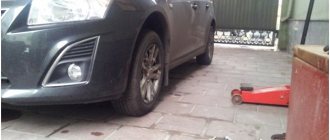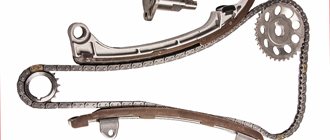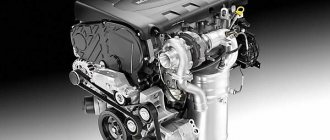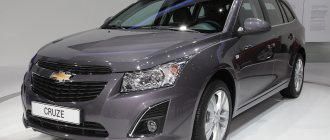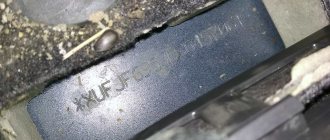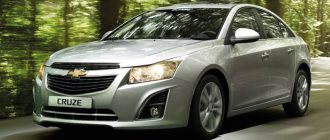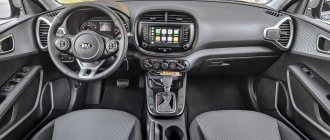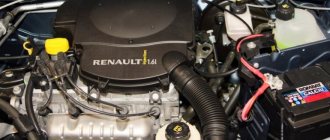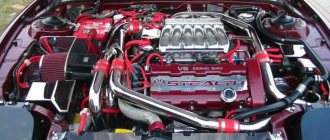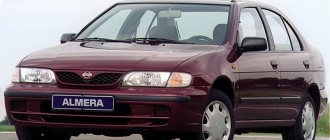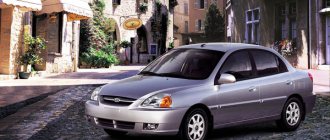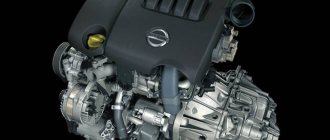In 2014, GM radically removed the entire budget Chevrolet line from the European market, leaving only exotic sports cars - the Camaro and Corvette. A year later, a similar reduction in the Chevy model range occurred in Russia. But the American brand has no plans to leave Ukraine yet: dealers continue to sell well-known models of different classes and even present some new items. So, in April I told you about event
, dedicated to the local start of sales
of the updated Cruze family
, and now I had the opportunity to get to know this car better during the traditional week-long test drive. The “test subject” was a station wagon in the top-end LTZ configuration: I decided to review it in the “pros and cons of the car” format.
Plus one: pleasant, calm appearance
Chevrolet Cruze
It’s no longer fresh: the model was first presented back in 2008 and this is already its second restyling. The first update took place in 2012, and the current version of the exterior design was presented in the fall of 2014 at the New York Auto Show. However, even now the car’s design looks relevant.
I am impressed by its classic “universal” proportions without any nods to the ubiquitous crossovers, calm lines and body contours. All this fits perfectly into the philosophy of a practical family car for every day. It is noteworthy that even after the completely new second generation Cruze entered the American market, the previous model continued to be sold to corporate clients and rental companies under the name Cruze Limited.
Plus number two: low cost
Plus the third: a convenient and spacious trunk
Station wagons are usually judged by their luggage compartment, and here the Cruze proved to be very confident. Having opened the fifth door, I immediately notice the low loading height and the almost complete absence of a side-step.
The trunk lid is fixed high: even a tall person will not rest his head. The volume of the compartment when traveling is exactly 500 liters, which is an average by the standards of the class. The curtain covering things not only rolls up, but can also be adjusted in height - depending on the amount of luggage.
Plus four: good handling
The first generation Cruze is built on the universal GM Delta II platform, which was developed by German Opel engineers and was also used on the Opel Astra J, Zafira, Ampera, Cascada. By the way, it was on the Cruz that it was tested for the first time. The front suspension here is a classic MacPherson strut, and the rear has a semi-independent torsion beam.
Despite the simplicity of the design, on a good road the car drives like a thoroughbred: very compact and tight. The picture is complemented by the informative steering - extremely sharp and precise, with “live” feedback: the car quickly and clearly responds to the driver’s commands. The “American” airiness and swagger that you subconsciously expect from cars with the Chevrolet badge are nowhere to be found here.
Minus one: increased fuel consumption
With the restyling of the Cruze, they began (in Ukraine) to offer a 1.4-liter GM Ecotec gasoline turbo engine with 140 hp. According to the creators, with the same power as the previous naturally aspirated 1.8 engine, the new unit not only provides better dynamics, but also consumes less fuel.
Minus two: adaptation to bad roads
If I wrote above about the pleasant elasticity of the chassis on good asphalt, then as the quality of the road surface deteriorates, the situation changes. Even on moderately rough roads, the chassis lacks energy intensity and smoothness: the suspension reacts rather “nervously” to holes, potholes and tram crossings—the car shakes quite a bit. It should be noted here that the station wagon’s suspension was initially made a little stiffer than that of the sedan: perhaps, when fully loaded, ride comfort will improve slightly.
On the other hand, for almost 1000 kilometers traveled, there were no outright breakdowns, however, and I drove extremely carefully. The technical specifications plate on the official website does not indicate the ground clearance of the car - I had to measure it myself: it turned out to be approximately 140 mm to the bottom point of the bottom.
Minus three: ergonomic miscalculations
In general, for a relatively budget model, the interior of the Chevrolet Cruze looks very decent: modern design, adequate quality of finishing materials. The design of the front panel successfully incorporates metal-look plastic, black lacquered elements, and wide fabric inserts. I don’t undertake to judge their durability and resistance to pollution, but it looks distinctive and original.
Starting with the mid-range LT trim, the car is equipped with an advanced MyLink multimedia system with a 7-inch color touch screen and advanced interaction with smartphones through the Apple Car Play and Android Auto programs. But, alas, there is no standard navigation here.
The climate control knobs are located too close to the edge of the “beard”: sometimes you touch them with your feet, arbitrarily changing the temperature or flow intensity (passenger).
It is not very convenient to use the on-board computer, since control is carried out by a ring on the steering column switch. To change the parameters displayed on the instrument panel display, you have to remove your hand from the steering wheel.
Minus four: poor sound insulation
If you usually communicate with passengers in a low voice, then in the Cruze you will have to change your habit, and the music will need to be turned up louder. The noise insulation of the model is still rather weak, this is especially noticeable at high speeds: the sounds of the suspension, aerodynamic noise, “singing” of tires and the clanking of small pebbles on the bottom and wheel arches actively penetrate into the cabin.
Let's summarize. Despite decent assembly line experience, the Chevrolet Cruze
still looks cheerful and is able to attract a purchasing audience. The strengths of this Korean-built station wagon are its competitive price, nice design, spacious interior and trunk, and a good level of equipment, starting from the mid-range LT trim level. The disadvantages include increased fuel consumption, an overly delicate suspension and not the best sound insulation. The model's main competitors in the domestic market are Ford Focus Wagon, KIA cee'd SW, Toyota Auris Touring Sports, Peugeot 308 SW, SEAT Leon ST and Volkswagen Golf Variant. Already when handing over the test car to the dealer, I noticed that in the price list, in parallel with the updated Cruze, there was also a pre-styling model, and in a very tempting version - with a powerful (163 hp) and economical 2.0-liter turbodiesel , 6-speed automatic transmission and at a reasonable price (491 thousand hryvnia).
History and equipment
The Chevrolet Cruze was developed and introduced in 2008 to replace the Lacetti, but they had little in common, only a 1.6-liter engine (F16D3). Otherwise, the new model is head and shoulders above its predecessor. Although it has not lost its simplicity of design, which made the Chevrolet Cruze accessible and desirable to the broad masses of car enthusiasts. The first generation went through two restylings and was sold in three types of bodies and different trim levels. Therefore, the choice on the secondary market is quite extensive with many nuances. Differences in configurations can be dramatic:
- From 2 to 6 airbags. The Cruze earned a 5-star Euro NCAP rating (with six airbags);
- Air conditioning or climate control;
- MyLink multimedia system, which appeared after restyling in 2012. Many owners of pre-restyling Cruzes also installed it. And the number of “crickets” in the cabin will depend on the level of work performed, since it was necessary to disassemble the entire front panel;
- Attributes of the richest LTZ package include light and rain sensors, heated seats, 17-inch wheels, parking sensors, a rear view camera, keyless entry and a stability control system.
Restyling in 2012 brought not only changes in appearance, but also added three engines to the range. One turbocharged petrol 1.4 liter and two diesel engines – 1.7 and a modernized 2.0 liter. In Russia, cars were assembled only with gasoline engines.
Tuning Chevrolet Cruze
Many car owners of cars from the first years of production independently engage in external tuning of their cars, turning them into restyled versions. Contrary to popular belief that a new body kit is produced by the manufacturer, this is not the case.
All such kits are produced by third parties that have nothing to do with the manufacturer. Despite this, external tuning of the Chevrolet Cruze is very popular in Russia, because in this way you can change the appearance of your car.
Interior and body
The oldest Chevrolet Cruze to date is not old enough to show serious corrosion. But there are no particular problems with this. Over the past decade, GM has significantly improved the issue of anti-corrosion body treatment. Potential risk areas (as with most cars) are wheel arches and sills. But the thickness of the metal let us down. It bends under the slightest pressure and over time the car becomes covered with many small dents. That's why there are a lot of tinted cars on the secondary market without accidents. Moreover, some owners of credit cars did this at the expense of CASCO insurance.
The external trunk opening button is poorly protected from moisture, so its service life is limited. Depending on the weather and how the car is stored, it can last from 10 to 50 thousand miles. If it starts to “glitch”, it is better to replace it, since damaged contacts can short-circuit and completely discharge the battery.
In frosty or rainy weather, all the windows of the Chevrolet Cruze, including the windshield, fog up. This cannot be corrected, since it is a design flaw. The air currents are not blowing properly.
Car interior and body before and after restyling
Since the very first models appeared in Russia only in 2009, even they do not have any special problems with corrosion. The manufacturing company took serious care of anti-corrosion treatment, so if the car has not been involved in serious accidents, the body is quite resistant. But the thickness of the metal is the weak point of all modern cars of this class. Dents appear on it even from pressing. Pre-restyling models became famous for their low-quality interior materials, which very quickly lose their appearance. After restyling, this problem was partially solved, although it is possible that this is only due to the age of the car.
In frost or rain, the windows fog up heavily, and both old and restyled models suffer from this problem. In general, for those who care about the appearance and condition of the Chevy’s interior, it is better to take a closer look at the newer modifications of the car.
Chevrolet Cruze engines
The most common engine is a 1.6 liter petrol engine. There were two types of them installed on the Chevrolet Cruze. The old F16D3, familiar to all service technicians, was installed on the Lacetti and Nexia. The motor has already been studied inside and out, but it has its weaknesses:
- It is imperative to change the timing belt with roller every 60,000 mileage. Otherwise, the pistons will meet the valves and the engine will have to be overhauled;
- It is better to replace a “snotty” valve cover gasket immediately. Otherwise, oil can flood the spark plug wells and “kill” high-voltage wires and ignition coils.
The relatively new ECOTEC F16D4, also known as Opel’s Z16XER, is a little more progressive and complex. Its 1.8-liter modification Z18XER has been installed on the Opel Vectra since the 2002 model year. This engine pulls stronger and consumes a little less gasoline, but it is technologically more complex and can be more expensive to maintain. Features of Z16XER/Z18XER:
- The timing belt needs to be changed less frequently, every 90-120 thousand mileage;
- Every 100,000 km the valves need to be adjusted, since there are no hydraulic compensators;
- The weak point is the heat exchanger. The housing bursts or the gasket leaks and oil flows onto the hot manifold. Most often this happens with regular and heavy load on a cold (unheated) engine;
- There was a recall campaign due to depressurization of the fuel rail (there were cases of fire under the hood), check with the seller whether this problem has been resolved;
- If the engine rumbles like a diesel engine, then you will have to change the camshaft gears and the phase shift solenoid valve. The problem is not “endemic”, but pay attention to the sound of the motor before purchasing.
Engines
Gasoline:
R4 1.4 Turbo (140hp)
R4 1.6 (113-124 hp)
R4 1.8 (141 hp)
Diesel:
R4 1.7 (130 hp)
R4 2.0 (125-150 hp) – a product of the Italian diesel engine manufacturer VM Motori
R4 2.0 (163 hp)
All of the above petrol units of the Ecotec series are well known from Opel cars. Engines in most cases do not pose serious problems. However, sometimes minor troubles happen. For example, owners regularly encounter oil leaks (from under the valve covers) or high oil consumption due to waste.
Chevrolets with Opel 1.6 and 1.8 XER did not avoid the “generic” diesel shift of the valve timing gears, which appears closer to 100,000 km. You have to change either the solenoid valves of the phase regulator (4,000 rubles) or the gears themselves (8,000 rubles).
Another unpleasant ailment is failure of the engine control unit. This happens due to water entering the unit (during washing the engine compartment or rain) and subsequent oxidation of the electronic board. For a new block of a 1.6-liter unit you will have to pay 10,000 rubles, and for a 1.8-liter unit - 20,000 rubles.
After 80-100 thousand km, sometimes the thermostat gives out: the heating element fails, or the housing cracks. A new thermostat is available for 3,000 rubles. By this time, the heat exchanger gaskets are tanned, which leads to mixing of antifreeze with oil. To fix the problem it will take about 10,000 rubles. In addition to the thermostat, the throttle valve heating tube can also leak (from 1,000 rubles) - it cracks from old age.
After 80-120 thousand km, misfires occur due to cracking of the ignition module housing. The cost of a new module is from 4,000 rubles.
The 1.4 Turbo downsizing unit is still very young, and it is too early to judge its reliability. However, here, too, the durability of the ignition module and thermostat does not differ, and in some units the pistons even burned out.
When choosing a Cruze with a gasoline engine, you should forget about sporting ambitions. But on the other hand, the dynamics of the naturally aspirated 1.8 and 1.4 Turbo are quite sufficient - acceleration to 100 km/h takes 10.2 and 9.5 seconds, respectively. In city traffic conditions, the car, depending on the engine size and its power, consumes from 9 to 11-12 l/100 km.
In addition to gasoline units, the engine range includes two diesel engines of 1.7 and 2.0 liters. The latest turbodiesel is available in three power options - from 125 to 163 hp. What worries them most often?
When used primarily in the city, there are problems with the particulate filter. The VM Motori-sourced 2-litre diesel can be found in the Hyundai i30, where it often suffers from dual-mass flywheel and turbocharger woes. However, owners of diesel Cruze have not yet encountered such problems.
Turbodiesels demonstrate a high level of performance and flexibility. The weakest 125-horsepower engine accelerates the car to the first hundred in just 10 seconds, and the strongest - in less than 9 seconds. At the same time, diesel engines pleasantly surprise with their low fuel consumption. So a 163-horsepower unit burns about 8.5 l/100 km in city traffic. It’s even scary to think how economical weaker engines are. But, in the end, the money saved will most likely be used for expensive repairs in the future.
Chevrolet Cruze gearbox
The Chevrolet Cruze has only two types of gearboxes - a five-speed manual and a six-speed automatic. The manual transmission does not raise any complaints, except for one weak point - the drive seals. They flow frequently, especially in late autumn or early spring, when sudden temperature changes occur. It is impossible to ignore such a breakdown. Without oil, even the most reliable mechanics will completely fail.
This is interesting: Geely Atlas test drive
Some owners installed an additional cooling system for the Chevrolet Cruze automatic transmission. But according to reviews from owners, this doesn’t make much sense. Additional cooling helps the box only under extreme loads; there is no difference in normal operation.
Motors
Russian-assembled Chevrolet Cruzes were all equipped with gasoline engines. They are quite reliable, but they still have some problems. The most popular engine is considered to be the 1.6-liter engine of the F16D3 series, which was inherited from the Chevrolet Lacetti, and before that, it was on the Daewoo Nexia. In general, the engine is normal, only after 60,000 km. The plastic valve cover gasket is starting to wear out; it costs only $12, but you still have to spend money on work. Over time, a lot of oil begins to leak out, it floods the spark plugs and damages the high-voltage wires. Deposits appear on valve stems.
After 100,000 km. mileage, oil begins to flow from everywhere - through the oil pan, head seals and even through the filler neck. Cars manufactured before 2013 may even stall at idle, the revs fluctuate. You also need to monitor the throttle valve so that it is clean, and do not forget to update the engine control unit programs.
There have also been cases where ignition coils failed, which cost $35; there is 1 coil for every 2 cylinders. The hydraulic mounts in the valve mechanism do not last long; they cost $10; to make them last longer, you just need to change the oil every 10,000 km, and not 15,000, as stated in the regulations. The engine uses a timing belt; you must also remember to change it on time.
There are also Ecotec engines that have been installed in the Opel Vectra since 2002. This is the Z series, there are 1.6-liter and 1.8-liter engines. About 34% of cars have 1.8-liter engines. In these engines, the timing belt is more reliable, there are no hydraulic pushers, so the valves must be adjusted using washers, but this will need to be done after about 150,000 km.
Chevrolet Cruzes produced before 2013 with a 1.8 engine were distinguished by a not particularly successful fuel line, in which depressurization could occur. Dealers even carried out a recall campaign on this matter, so you need to find out from the previous owner whether the connections in the fuel line were changed; if not, then it is better to do it yourself. The ECU under the hood is not located particularly well, so if you decide to wash the engine, you need to do it carefully, because if water gets into the block, it will fail.
If diesel rattling suddenly appears in the engine after a mileage of 80,000 km, then this means that you need to look under the valve cover. You will have to replace gears that are worn out, they cost about $100, also camshafts with a variable valve timing system and an electromagnetic valve that controls the phase shift, if a filter mesh is clogged in it, such a valve costs $65. The oil scraper rings are stuck, so oil consumption increases to 1 liter per 1000 km. Therefore, it is necessary to monitor the oil level, change it more often, and it is also advisable to change the spark plugs on time so that the ignition module does not fail.
You can also find the newest engine on the Cruze - a turbocharged 1.4 - A14 series, which first appeared on the Opel Astra in 2009. In 2013, they already began to install it on post-restyling Cruzes. This engine also likes to eat oil because it leaks out through the valve cover. But for a long time there are no problems with the hydraulic valve supports, turbocharger and timing drive. The only thing that can happen is the failure of the mass air flow sensor after 80,000 km, it costs $130. Also, the canister and intake manifold valves may become clogged. It also happens that the pump bearing starts to whistle, it costs $50.
Suspension and steering
There are a couple of problems that technically do not affect anything, but psychologically irritate Cruze owners:
- Knock of calipers. The best solution is to pack the guides with thick lubricant. Needs to be repeated regularly.
- Knock of shock absorbers. Replacing with non-original ones, most often Bilstein, helps. On the secondary market, 90% have already been replaced.
After restyling, the manufacturer eliminated both problems.
In the Chevrolet Cruze steering, weak points are also associated with sound. The power steering pump often starts to make a lot of noise. Sometimes tying up the hydraulic hoses and replacing the fluid helps; more often the pump needs to be replaced. After 2012, the system became hydroelectric and there were fewer problems.
Restyling Chevrolet Cruze
In Russia, Chevrolet Cruze cars are incredibly popular. Since official sales started here in 2009, there are currently many cars of this brand traveling on the roads of our country. The car is also popular on the secondary market.
In this regard, car enthusiasts who want to buy a Chevrolet Cruze second-hand have a question: which car is better, restyling or pre-restyling? In order to answer it, you need to carefully consider all the differences between the modifications released at different times.
Chevrolet › What is the recipe for the Chevrolet Cruze sedan?
Chevrolet Cruze is an undoubted success of Korean designers. But was the international engineering team really that diligent?
Globalization is evil, so says the progressive part of our society. Hamburgers from McDonald's and pizza from Sbarro have turned not the most sophisticated dishes into synonymous with tasteless poison. If a film manages without explosions, piles of corpses and a saved world, then it can already qualify for some kind of award - for an unusual approach.
You can talk for a long time about the harmfulness of all these things, but the result is the same: you will still go to the cinema, grab some popcorn and watch with pleasure how Bruce Willis, swearing, crushes the skull of another villain. Simple, clear and accessible.
In photographs, the Cruze looks quite massive, although the length has increased by only 64 mm compared to the Lacetti to almost 4.6 m. But this is enough to be one foot in the D class.
It's about the same with cars. The Volkswagen Beetle was popular not because it drove in any special way. The Citroen 2CV was called an “umbrella on wheels”. As for safety, during the accident, both cars, like Bruce Willis, told their owner: “Die, you bastard!” When you need to fill your stomach quickly and inexpensively, it’s hard to come up with something better than McDonald’s.
It's a similar story with modern cars like the Chevrolet Lacetti: it's tasteless, but inexpensive and satisfying. Now it has been replaced by the Chevrolet Cruze. This is also a Korean car, and it is inexpensive. That is, the recipe is similar. But why then was it necessary to change the name - from the usual to the dubious?
The share of high-strength steels in the body structure is not so high - about a third. But its rigidity has more than doubled. As for safety, the “base” includes six airbags and a dynamic stabilization system. True, not on the simplest modification with a 113-horsepower 1.6 gasoline engine.
Perhaps the previous name was so clearly associated among buyers with the image of “an inexpensive workhorse for a strong businessman” that it was decided to change it immediately. Even aesthetes shouldn’t turn their nose up at the car. “Plus,” say the DJs, “this car is the first to try on the new corporate style. And this needs to be noted somehow.
Although the style of the “forehead cut by a pile” seems to be the same, the presentation of the dish has definitely changed. The Lacetti sedan was not a freak. But he could only be compared with the heroes of mid-budget American films: they seem to play well, but are forgotten as soon as the credits begin. By the way, you can’t remember what the movie was about either: the Lacetti was driving in no way.
There is a plastic insert in the rear pillar instead of a real window. But how the profile played!
And the Cruise has heartily inflated wheel arches and a good profile (although instead of a window in the rear pillar there is a plug); for those who are especially demanding, there is even a chrome exhaust tip. The main thing is not to discuss the rear: the conversation will still come down to an argument about whether the Cruze is similar to the Civic. In general, I had one question about the design: “Why are almost all the Cruises at the presentation gray? Are there really no brighter colors for such a car?” It's a compliment.
How is Cruze fundamentally different from Captiva, Epica or Aveo? Small details. Or rather, a bunch of details! The salon is interesting not only to look at, but also, imagine, to touch. It is made with love for details. Architecture a la Cadillac CTS and cool “fabric-like” inserts on the front panel (on versions with a leather interior they are made of “leather”, but they look much worse).
The salon is made of inexpensive materials, but with design delights. The steering wheel is a little big, but quite comfortable (by the way, the buttons on it are the same as, for example, on the Opel Insignia model). The devices are beautiful, but they glare in bright light. Climate control (optional) works tolerably, but the on-board computer menu is confusing.
A steering wheel with lugs for the correct grip, seats with good lateral support, a comfortable seating position (the steering column is adjustable for height and reach), elegant instruments. Light control unit - with chrome rim. Acceptable standard audio system. The list could take a long time.
The front seats have very good lateral support. There is moderate room in the back, both in the legs and in the head. There are niches for small items in the front and rear doors.
But there are also plenty of shortcomings. The ceiling handles are devoid of micro-lifts, but the entire interior is in micro-lifts. The buttons are not pressed perfectly clearly, the glove compartment lid does not close perfectly smoothly - and the list goes on. In terms of interior quality, it’s too early to classify the Cruze as a competitor to the same Opel. But the quality is there! In terms of interior design, the Cruze is perhaps the most interesting “Korean” we've seen in recent years. But technically, alas, it is no more interesting than a Big Mac. Standard recipe?
The trunk has a volume of 450 liters. Inside, there are folding rear seatbacks and a full-size spare tire in the “underground”.
This Chevrolet was developed where it usually is - in Korea (no matter how unsightly this phrase may seem). And as usual - with a Jimmy unification scope. The 1.6 petrol engine was taken from Lacetti; The 1.8 engine, on the contrary, is from Astrov. The two-liter diesel is Korean, GM DAT division: it can be found in Captiva and Antara. And their own gearboxes. The five-speed “mechanics” with large, tasteless moves and mediocre selectivity is the same as on the Lacetti. But the “automatic” is borrowed from the Epica sedan: a very modern, six-speed gearbox – something that Corolla would be jealous of.
The main thing is not just a “Korean” Daewoo (although Cruze is sold under this brand at home), photographed against the backdrop of the Statue of Liberty. The platform here is new - Delta II, developed in Rüsselsheim by the Opel team (the new Astra will also be built on it). Moreover, it is alleged that the Germans taught how to drive a car. At least the European version, which has a stiffer suspension than the Korean or American one.
At first, the handling even seems sharp - the car willingly and quickly changes course. For a city, such agility is just right. There is only one problem: there is a lack of accuracy - on a steep arc the trajectory must be constantly corrected.
“But the Cruze, compared to the Astra, is more comfortable and drives better on bad roads!” — the Jimmy guys answer. Indeed, the current Astra is more accurate and sharper, but at the same time it jumps off the trajectory more often on uneven surfaces, and the steering wheel kicks more strongly in ruts. More interesting, but tougher and more nervous.
Cruise's rear brakes are disc on all versions.
Cruze, in general, is also not very soft, although there is considerable roll in sharp turns. But on rare bad sections of Spanish roads, the suspension seemed very dense and elastic. And there is almost no rocking on the waves. It's better this way! It's a pity that the turns are given without enthusiasm.
I let off the gas, and everything becomes completely fine. On the highway, the Cruze handles well - calm reactions and good directional stability (the wheelbase here is longer than that of many of its classmates). Plus - good sound insulation. The only thing that spoils it is the engines, which squeal like a child whose favorite toy was taken away.
Cruise has a fairly sharp steering wheel - 2.7 turns from lock to lock. That is, the car should be more comfortable in the mountains than on the highway. But on the highway the car behaves more confidently, and on the serpentine roads it gives in.
The petrol 1.8 is especially noisy in combination with an automatic transmission. After active driving, you want to stick a banana in the exhaust pipe. Will it suddenly become quieter? Apparently, his voice and the “machine gun” can’t stand it—sometimes he stumbles. Although, in general, the combination is not bad, but when driving fast, the engine gets boring, and when driving calmly, the transmission jolts: due to the low torque at the bottom, the box has to constantly shift. The younger engine comes only with a five-speed manual transmission. And, surprisingly, he screams less. But with it, the Cruze drives completely boring. There is even less elasticity, and you don’t want to switch more often: the gearbox is not ideal.
The quietest, oddly enough, is a two-liter diesel! Not a bad engine, almost devoid of unpleasant vibrations and characteristic rattling. Like any modern diesel engine, it doesn’t pull well at the bottom, but by two thousand it produces 320 N•m of torque. And this is not a joke. “Automatic” with such traction becomes silky: the car is responsive at a walk, a gallop, and everywhere in between. No jamming, no jerking. This is where six gears are used perfectly! It's a pity that diesel is not for us.
The positioning is also not completely clear. In most markets, the Cruze will replace the Lacetti, but in our case the two cars will sit side by side. The old one is on the Avtotor conveyor belt, the new one is in Shushary. So, Cruze will be a little more expensive than Lacetti and cheaper than Astra? But the new Astra is coming out soon, and then the Cruze will be exactly in the place of the old one. It is known that we will have the first cars by summer, and all of them will be domestically assembled.
But no matter what marketers come up with, Cruze is a breakthrough. After all, if you drive a Lacetti like it’s jelly, then the Cruze is an Astra that just took valerian. But with a tight suspension and quick reactions. After all, in Europe the average age of a buyer will be 40–50 years. And this immediately puts everything in its place: why the engines have no spark, and why the handling is safe and boring. Why does a forty- or fifty-year-old need a peppy engine sound and skidding when releasing the gas? To die of a heart attack?
This is interesting: Test drive Skoda Kodiak
Apart from the sedan, Cruise has no other body styles yet. A hatchback is in the distant future. And instead of a station wagon, a single-volume Orlando will be made - also a child of Korean developers.
But the rest of the car is good. Korean designers have made the Cruze look more American than, for example, the Chevrolet Tahoe. Most likely, the Cruze is as reliable as the law of gravity. Yes, this is still a type of drive-thru fast food. Only earlier this unified cocktail was devoid of both vitamins and taste. And now the taste is already emerging.
And if the price doesn’t let us down, then for many people this will become a serious argument. After all, you can buy a big TV with the money you save. The action there these days is through the roof.
All generations of Chevrolet Cruze
2015 – today
II
2012 – 2014
J300 rest.
2008 – 2012
J300
Fast passage
- A Acura
- Alfa Romeo
- Alpina
- Alpine
- Aston Martin
- Audi
- Aurus
- B Bajaj
- Bentley
- BMW
- Brilliance
- Bugatti
- BYD
- C Cadillac
- Caterham
- Changan
- Chery
- CheryExeed
- Chevrolet
- Chrysler
- Citroen
- Daewoo
- Daihatsu
- Dartz Motors
- Datsun
- Detroit Electric
- DFM
- Dodge
- FFAW
- Ferrari
- Fiat
- Ford
- Foton
- G GAC
- GAZ
- Geely
- Genesis
- GMC
- Great Wall
- GTA Motor
- H Hafei
- Haima
- Haval
- Hawtai
- Hennessey
- Honda
- Hummer
- Hyundai
- I Icon
- Infiniti
- Iran Khodro
- Isuzu
- JJAC
- Jaguar
- Jeep
- K KIA
- Koenigsegg
- L Lada
- Lamborghini
- Land Rover
- Lexus
- LIFAN
- Lincoln
- Lotus
- Luxgen
- M Marussia
- Maserati
- Maybach
- Mazda
- Mazzanti
- McLaren
- Mercedes-Benz
- MG Cars
- MINI
- Mitsubishi
- N Nissan
- Opel
- P Pagani
- Peugeot
- PGO
- Porsche
- Proton
- Q Qoros
- Ravon
- Renault
- Rolls-Royce
- S Saab
- Samsung
- SEAT
- SeAZ
- Skoda
- Smart
- SsangYong
- Subaru
- Suzuki
Go
The Chevrolet Cruze is a Korean project of the General Motors concern. The car was developed under the leadership of Tevan Kim. The Cruze replaces the unrelated Lacetti and Cobalt models. The car is designed on the new global platform Delta II, on which the Opel Astra J was already assembled. The debut of the Chevrolet Cruze for the domestic market of South Korea took place in 2008. South Korean car enthusiasts know the model under the name Daewoo Lacetti Premiere. Here it was intended to replace the Lacetti model, sold since 2003. A full replacement was carried out by General Motors in 2009. In Australia, the car has been known under the name Holden Cruze since 2009. In Russia, the Cruze model is produced at the General Motors plant in Shushary, Leningrad region. The car appeared in Russian showrooms in the fall of 2009. But GM planned to release the car on the Russian market in the spring of 2009. It is noteworthy that along with the new car, you can also purchase an early generation of Chevrolet Lacetti from Russian official dealers. The Russian version of the car is equipped with one of two engines with a displacement of 1.6 and 1.8 liters and an automatic or manual transmission.
The production model of the Chevrolet Cruze Hatchback was presented at the Geneva Motor Show in March 2011. In comparison with the sedan, which has been rolling off the assembly line since 2008, the appearance of the front end has remained virtually unchanged, however, the silhouette and rear of the body look different. In terms of dimensions, the 2011 Chevrolet Cruze is 8.7 cm shorter, but the width of the wheelbase remains the same. The hatchback trunk volume is 413 liters, which is an increase of 37 liters. less than that of a sedan, and with the rear seats folded down, the luggage compartment increases to 883 liters. On the Russian market, the new Chevrolet Cruze Hatchback is available with two gasoline engines, familiar to buyers of cars with a 4-door body. With a volume of 1.6 and 1.8 liters, they develop 109 and 141 hp, respectively. Both engines are combined with both a 5-speed manual transmission and a 6-speed automatic transmission. The only change is that the power units of the new Chevrolet Cruze 2011 meet Euro-5 standards and are characterized by reduced CO² emissions. In December 2011, mass production of the Chevrolet Cruze Hatchback began in Shushary, where the sedan and three models under the brand are also assembled Opel The car is available in three trim levels: Base, LS and LT, and potential buyers are offered a choice of 3 classic colors: white, black and silver. At the same time, it is expected that starting from the spring of 2012, the range of colors for the 2011 Chevrolet Cruze will expand to 8. In the basic configuration, the 2011 Chevrolet Cruze is equipped with electrically adjustable and heated mirrors, 4 airbags, ABS and an audio system with 4 speakers. In the top configuration, the car will receive climate control, 6 airbags, parking radar, traction control, light and rain sensors. It remains to add that the Chevrolet Cruze Hatchback will appear in Russian dealerships in January 2012, and the sedan is currently one of the three best-selling foreign cars in Russia.
Chevrolet Cruze exterior design
While working on the appearance of the second-generation model, its creators decided to adhere to the corporate style in which other representatives of the Chevrolet line are decorated - the older Impala and Malibu models. Thanks to this approach, the appearance of the car turned out to be more expressive and aggressive than that of its predecessor model. In addition to the modified appearance design, the new product has noticeably increased in size, while becoming a little lighter.
Perhaps the main changes to the exterior design affected the front part of the car. The front end is decorated with an original two-level radiator grille, made in the form of a coarse mesh. The predatory squint of the diode-filled head optics organically complements the front bumper of a complex multifaceted configuration with fog lamp inserts and protection made of black unpainted plastic.
The sedan's silhouette looks sporty and attractive. The speed of the Chevrolet Cruze is given by the domed roof profile, which smoothly flows into the front and rear pillars. The sides of the body are decorated with relief stampings and stiffening ribs that cross the car horizontally from the front fenders to the rear wheel arches. Directly above the rear window, the roof of the car is decorated with a “shark fin” of an active antenna.
The short trunk lip and sloping hood give the car the appearance of a four-door coupe. The sporty exterior mirror housings are mounted on feet. The compact rear part, decorated with beautiful side lamp shades, and the sculpted bumper emphasize the overall sporty appearance of the car.
For an additional fee, the future buyer of the car will be able to order a special “RS” package, designed to make the car’s appearance even more “hot.” The optional RS package includes a modified radiator grille, different thresholds, a splitter for the front bumper and a small spoiler on the trunk lid. In addition, the tuned car is equipped with 18-inch light alloy wheels. Thanks to the smooth and streamlined body shape, the new Cruze has one of the best in its class aerodynamic resistance to oncoming air flows, equal to 0.29 Cx.
The increase in the dimensions of the car primarily affected the length of the sedan body and the size of its wheelbase. Compared to the first generation model, the new Cruze has lengthened by 69 mm, reaching 4666 mm; the wheelbase of the car has increased by 15 mm, amounting to 2700 mm. The width of the car is 1795 mm, the height is 1458 mm. The ground clearance of the car is quite standard for a city sedan and is 140 mm. The basic American sedan rests on the asphalt with 15-inch wheels.
Body and interior
Body elements are made of thin sheet metal, which remains dents even after a relatively minor impact. The quality of the paintwork leaves much to be desired. Fortunately, the metal in the chipped areas is in no hurry to bloom, and there are no complaints about corrosion yet.
Sometimes the flimsy mounting of the front and rear bumpers is upsetting. Over time, it sags and a gap forms. To eliminate the problem, it is necessary to replace the brackets. The rear bumper fastening latches are also not strong.
There are also complaints about interior finishing materials. Even with low mileage, signs of wear appear on the seats, steering wheel and silver inserts on the front panel. The rest of the plastic in the cabin is also easily scratched.
Interior decoration 2016 Chevrolet Cruze
Assessing the interior design of the new Chevrolet Cruze, we can affirmatively say that the interior of the car has retained the quite recognizable architecture of the previous generation of the sedan. At the same time, engineers and designers tried to make the interior of the new car more modern and stylish. The main place on the impressive front panel of the sedan is given to the large MyLink multimedia display, which, depending on the equipment level of the car, can be 7 or 8 inches diagonal. Just below the display are blocks with two pairs of large “knobs” and several large buttons for the air conditioning system and audio system. To the left and right of the central display there is a place for ventilation system deflectors, decorated with chrome trim.
The new three-spoke steering wheel with several control keys for on-board functionality fits well into the overall interior ambiance.
Directly in front of the driver there is a nice dashboard with a pair of dials for the speedometer and tachometer, between which there is a place for a small but clearly readable on-board computer display.
According to the manufacturers, higher quality plastics of the new generation are used to decorate the car interior. In addition, the developers took a more careful approach to the build quality of the interior - the plastic elements are clearly fitted, all the joints and gaps in the cabin look smooth and identical.
Continuing to compare the new car with the version of the previous generation, it must be said that the Cruze’s interior now not only looks more modern and stylish, but is also made noticeably more friendly to accommodate the driver and passengers. Front seat occupants are offered comfortable, ergonomic seats with a wide range of settings and an optimal backrest profile. The driver's seat is organized in such a way that while driving the car, the driver is minimally distracted from the road - all the main buttons and levers are located at hand, and the view of the dashboard is not blocked by anything.
The space in the second row of the five-seater sedan has increased noticeably - with an indicator of 917 mm, according to this criterion, the new Cruz is the best car in its class.
The machine has a good level of equipment already in the standard version. The car owner's arsenal in the basic version will include: the proprietary Chevrolet MyLink multimedia complex, capable of working with mobile devices based on Android and Apple, an electric handbrake, a modern climate system, a rearview camera, a heated steering wheel and front seats, as well as ten airbags.
The list of additional equipment is even more extensive, among which noteworthy options include: a large display of a multimedia complex, a charger for wireless smartphones, a Wi-Fi hotspot for distributing mobile Internet, navigation, electric drive seats for the driver and front passenger. , leather interior trim, as well as a whole list of modern electronic active safety devices.
Power unit and transmission Chevrolet Cruze station wagon
The Cruze station wagon is equipped with a standard GM set of four-cylinder internal combustion engines, including two gasoline engines and two diesel options:
| Engine | Power | Maximum torque | Fuel supply system |
| Petrol Ecotec 1.6, F16D4 | 124 hp | 150 Nm | Distributed injection |
| Petrol Ecotec 1.8, F18D4 | 141 hp | 176 Nm | Distributed injection |
| Turbodiesel 1.7, Z17DTR | 130 hp | 300 Nm | Common Rail |
| Turbodiesel 2.0, Z20D1 | 150 hp | 360 Nm | Common Rail |
Unfortunately, diesel station wagons are aimed at European consumers and were not delivered to our country. However, a certain number of Chevrolet Cruze Wagon VDCi still run on Russian roads, so it is quite possible to find a similar car on the secondary car market.
The smaller engines are equipped exclusively with a D16 manual gearbox with a cable-type control drive. For the 1.8 engine and two-liter diesel engine, a choice is available: a five-speed manual or a six-speed automatic of the 6T30/6T40/6T45 modifications.
The manual transmission uses SAE 80W GL-4 or SAE 75W-90 oil; the automatic transmission uses Dexron VI type gear lubricant.
Depending on the installed engine and transmission type, the Chevrolet Cruze Wagon shows the following dynamic characteristics:
| Engine/gearbox | Acceleration to hundreds | Maximum speed | Fuel consumption per 100 km (mixed mode) |
| 1.6 MT | 12.6 sec. | 191 km/h | 6.6 liter AI-95 |
| 1.8 MT | 11.0 sec. | 200 km/h | 6.7 liter AI-95 |
| 1.8 AT | 11.5 sec. | 192 km/h | 7.2 liter AI-95 |
| 1.7 VDCi MT | 10.4 sec. | 200 km/h | 4.5 liter diesel engine |
| 2.0 VDCi MT | 8.8 sec. | 210 km/h | 5.2 liter diesel fuel |
| 2.0 VDCi AT | 9.8 sec. | 205 km/h | 6.3 liter diesel engine |
Technical characteristics of Cruz
At first, the updated Cruze will be offered with the only available gasoline engine, in addition to which a diesel engine will be added a little later. The current engine is a four-cylinder turbocharged engine with a displacement of 1.4 liters, developing a maximum power of 153 hp. A special feature of this unit is the use of technologies aimed at significantly reducing friction processes, the presence of an aluminum cylinder block, as well as the use of a direct fuel injection system. In addition, the engine is equipped with a start/stop system. A peak torque of 240 Nm is available in the operating range from 2000 to 4000 rpm. According to the developers, the installed engine has good fuel efficiency, consuming about 5.8 liters of fuel per 100 km in mixed driving mode.
There are two gearboxes - six-speed manual and automatic. When developing the car, the front-wheel drive D2 platform, developed by General Motors engineers, was used, thanks to which the weight of the car was reduced by 113 kg, while body rigidity increased by 27% due to the use of steel made using hot stamping technology in the construction of body structures.
The front wheel axle is provided with an aluminum spring suspension, including MacPherson struts. At the rear, the company's engineers installed a torsion beam, complemented by a Watt mechanism. The new sedan received disc brakes on all four wheels. The front brake discs are ventilated. To assist the driver, ABS, electronic stabilization system, and electric power steering are offered.
According to preliminary data, there are no plans to officially sell the new Cruze in Russia, and therefore prices for the car in our country have not been set.
Model specifications
Like the rest of the Cruze line, the station wagon is built on the global “GM Delta II” platform and has the following design features:
- transverse arrangement of the motor;
- front-wheel drive;
- independent wishbone-spring front suspension (MacPherson strut);
- semi-independent rear suspension with trailing arms and elastic transverse beam.
GM paid the most serious attention to the safety of the station wagon: tests of the Chevrolet Cruze using Euro NCAP methods brought it the highest score (5 stars).
In terms of carbon dioxide emissions, the Cruze Wagon complies with Euro 5 environmental standards. Sales of the Chevrolet Cruze Wagon (J300 generation) started in 2012; production of the car continued until 2015. In 2021 - 2017, a new generation Chevrolet Cruze appeared, but, unfortunately, the official dealer will not supply this model to the Russian market.
Feelings behind the wheel of a Chevrolet Cruze
The car is quite strong, in 2009 they even carried out a Euro NCAP crash test, where a car with 6 airbags received the maximum rating. During the impact, the interior was almost not deformed, and the doors opened. In the event of a frontal impact, the driver and passenger are normally protected. Serious injuries can also be avoided in a side impact. Children in child seats will also be well protected, but the safety of crossings here is quite low, because the edge of the hood is quite dangerous.
If you drive this car, you will immediately notice that it is slightly slow up to 3000 rpm, and at high speeds the automatic does not allow you to drive briskly, because it is leisurely. Also, the car does not have a sport mode, but there is a manual mode in which you can drive more quickly, but the main thing is not to forget to switch gears, because in manual mode the box itself will not shift either up or down.
Cruise's handling is not the best, sensitivity to steering inputs is low. If the car drives in an arc, the steering wheel turns a little on its own, you need to get used to this. The car has a stabilization system that cannot be turned off. In terms of comfort, the Cruze sedan handles bumps better than the hatchback on bad roads. But the energy intensity of the suspension is clearly not enough. Each hole is strongly felt. But in general, the Chevrolet Cruze is a good car for the money, it is not much worse than other cars in this class, but it is much cheaper.
You can also read on this topic:
Used Citroen C5 and features of caring for it
Dodge Ram 1500 and its technical characteristics
Toyota Land Cruiser - an indestructible off-road conqueror
Mini Cooper is not very popular on the secondary market? - Why?
Mercedes S-Class in the back of W221 and its maintenance costs
Share on social networks
Alexander Stepanoff January 3, 2017
Posted in: American Cars
Tags: used cars, American cars
